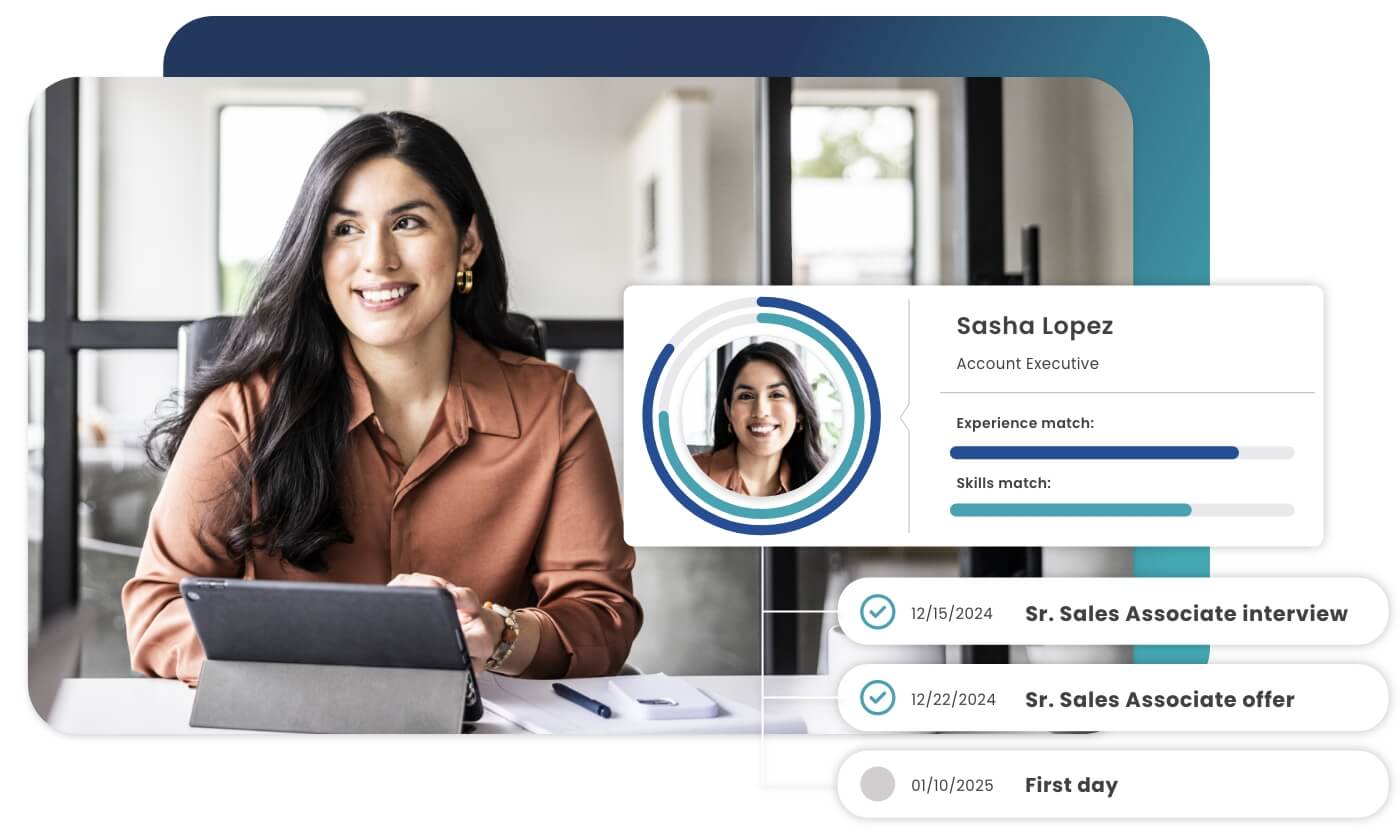

Talent acquisition and HR leaders are spread thin by today’s turbulent job market and rising pressure to fill open roles quickly with the best, most-qualified candidates.
It’s a challenging landscape where traditional recruitment methods often fail to deliver meaningful results. No doubt you’re juggling many competing priorities: lowering time-to-hire, sorting through hundreds of applications, and overseeing and guiding your team to recruit effectively.
The following recruitment tips will help you navigate these pitfalls, whether you’re leading a team of two recruiters or twenty-two. By championing the right software and data-driven strategies, you can empower your team to work smarter (not harder) and achieve fantastic outcomes from your recruitment process.
Many talent acquisition leaders struggle to encourage their teams to adopt technology into their weekly workflows.
The answer? Artificial intelligence (AI) is emerging as a powerful tool for today’s recruitment needs, especially for enterprise recruiters trying to manage high-volume hiring.
AI-powered tools can save talent acquisition teams considerable time by automating repetitive tasks. So, your recruiters can focus on where they excel: building and nurturing relationships with candidates and making smart hiring decisions.
Finding the right talent—quickly and effectively—remains a top challenge for recruiters. To alleviate this pain point, AI-powered candidate sourcing tools can scan thousands of potential candidate profiles and resumes to identify who is the best skills match for your open roles.
iCIMS AI, for example, was shown to halve time-to-fill for clients using our platform. Its AI technology makes it faster and easier for recruiters to identify the right candidates, even scoring their engagement to indicate who is most interested in working for you.
Communication with candidates often suffers when your recruitment team is overwhelmed.
Enter AI-drive chatbots to the rescue. These chatbots can handle the initial screening of candidates and answer FAQs about the role, company, and hiring process.
By working 24/7, these virtual assistants can assist their human colleagues in:
With AI chatbots, every candidate receives a quick response and immediate attention, while recruiters’ time is freed up to focus on higher urgency tasks.
Gut feelings and intuition will always have a place in recruiting, but the most successful recruiters rely on data to guide their hiring strategies.
By tracking the right metrics and data analytics, you will support your talent acquisition team in making more informed decisions that lead to better hires.
Data-driven recruitment can resolve bottlenecks, identify which sourcing channels work best, and even help predict which candidates are likely to thrive long-term.
Talent acquisition leaders know they need to monitor the right recruitment metrics to lead their teams to success.
Here are recruitment KPIs that can deliver valuable insights into your hiring pipeline:
By reviewing these metrics often, you and your team can strategically spot trends, set better goals, and determine when adjustments are needed.
Take data-driven recruitment to the next level with advanced analytics and talent assessments.
These methods can help predict early on which candidates are mostly likely to succeed at your company. Explore how you can employ them for better hiring outcomes:
Throughout the hiring process, the experience you offer candidates can make or break your ability to secure top talent—both now and into the future.
After all, the best candidates often have multiple offers. Deciding which company to join may come down to how valued they felt during the recruitment process.
A positive candidate experience does more than increase offer acceptance rates. It also strengthens your employer brand, encourages staff referrals, reduces the odds of negative online reviews, and creates a pipeline of engaged candidates for future openings.
Generic mass emails and long periods of silence are guaranteed ways to lose promising candidates.
Prevent this outcome by developing strategies for personalized communication to keep top talent engaged and informed throughout the hiring pipeline.
Where to start? These are simple but effective strategies you can implement:
Collecting candidate feedback can give you better awareness of the strengths and weaknesses in your recruitment workflows.
Consider using surveys at different stages during the hiring journey. Ask candidates their opinions on the interview process experience, recruiter communication, and initial impressions of your company.
But don’t just sit on these valuable insights! Leverage them to take real action and improve the candidate experience. Share key feedback with your recruiters and hiring managers, celebrate what’s working well, strategize together about any areas that need refinement, and then follow through on your plans.
When candidates see their feedback acted upon, it reinforces that your company is open to input and committed to positive growth.
The right recruitment solutions can keep candidates engaged and happy—while reducing your team’s workload at the same time.
Candidate relationship management software can help recruiters stay in touch with applicants and send them content based on their interests by leveraging email campaigns, text messages, and AI-powered chatbots.
Consistent, personalized engagement keeps hot leads from cooling off and brings your company top-of-mind with more passive candidates, who might be perfect fits for future openings.
Embracing new and specialized solutions for recruitment can greatly help in streamlining your workflows, particularly for enterprise companies that hire in large volumes.
As a talent acquisition manager, your team depends on its tech stack to tackle the many weekly tasks associated with maintaining the hiring pipeline. So, investing in the right tools is key.
What matters is selecting recruitment technology that supports your existing processes and alleviates major pain points. For recruiters, the best tools automate repetitive tasks and boost their human ability—rather than replace it—giving back the time and energy to build relationships with candidates.
Choosing the right enterprise applicant tracking system (ATS) provides the foundation for building a great recruitment tech stack.
Today, an ATS platform can accomplish far more than storing resumes. The one you select should be able to oversee the entire recruitment workflow—from job description approval to offer acceptance.
Look for a system that can manage, automate, and streamline your hiring workflows for all roles and departments. AI-powered filtering is also invaluable for quickly identifying top talent from large applicant pools.
Modern platforms, like iCIMS Hire (the core of which is our ATS), can even accelerate candidate engagement with email templates and support for cross-channel communication. Because once you find great talent, you also want to keep them.
Recruit from anywhere in the world with video interviewing software. Adding flexibility to the screening process, these platforms offer live and pre-recording interview options, so it’s easier than ever for candidates and recruiters to connect.
Pre-recorded interviews give candidates the opportunity to answer questions on their own time. Plus, the recordings are convenient for recruiters and hiring managers to review at their leisure. No need to worry about scheduling conflicts or being in different time zones.
For live interviews, video platforms offer recording capabilities, so the recruitment team can watch the conversation again. Video interviewing is natively integrated into iCIMS Hire for effortless post-interview feedback, tracking and reporting.
Adding an AI recruiting chatbot to your career site can help recruiters keep up with candidate communications. In fact, these digital assistants can answer FAQs, perform initial screenings, and even schedule interviews without human oversight.
iCIMS AI includes chatbots that can converse with applicants in different languages, and can be integrated with SMS, web chat, and Meta platforms, including Facebook Messenger and WhatsApp.
Recruitment is a fast-paced industry with new challenges appearing often. To remain competitive, talent acquisition leaders should nurture a culture of flexibility, adaptation, and continuous learning within their teams.
Let’s explore how you can set up your recruiters for long-term success with the necessary tools and knowledge.
Skills and strategies that recruiters used in the past are much different from what’s needed today.
To stay current, commit to your team’s personal development, so they’re able to adapt to changing job markets, meet candidate expectations, and leverage the latest tools, recruiting metrics, and analytics with ease.
You can create learning paths for your individual recruiters, tailored to their unique career goals and any skills gaps. These plans might include learning opportunities like:
By championing your team’s continuous learning and development, they will gain the knowledge to benefit both their own careers and the company’s recruitment efforts.
Brand visibility helps your company stand out to qualified candidates and inspire them to apply.
More than ever, job seekers want to work for a company that aligns with their personal values. Due to this, it’s important to build a compelling employer brand, clearly displaying your values, culture, and employee experience.
Recruitment marketing software can help amplify these efforts.
iCIMS Employer Branding, for instance, makes it simple to create modern career sites. Showcase your workplace environment through branded content, carousels, and video testimonials. Plus, leverage AI to engage candidates with an AI-driven chatbot and refer them to the best roles for their backgrounds.
When recruiting, it’s integral to uphold compliance and adhere to the DEI policies in place. Non-compliant hiring practices can lead to serious consequences, including legal issues, damage to your brand, and a lack of diversity in the workplace.
Here are some best practices to ensure your hiring stays compliant and ethical:
Keep in mind: ethical hiring goes beyond legal compliance. It means treating every applicant with respect, communicating in a timely, kind manner, and staying true to the company’s stated values in your recruiting practices.
With a little effort, recruitment leaders can reframe the challenges facing their teams as opportunities to optimize their hiring processes for consistent and long-term success.
Start by evaluating your recruitment workflows against the tips outlined in this blog. Identify one or two areas where improvements would have the greatest impact. Focus on those first before tackling the others.
Remember that sustainable change happens step-by-step. Small, consistent improvements add up to big transformation over time—especially when you’re using the best technology, metrics, and practices to achieve your objectives.
Need support in empowering your talent acquisition team? Let’s discuss your company’s recruitment goals and how you can accelerate your hiring pipeline while reducing cost-to-hire. Book a demo of iCIMS here.